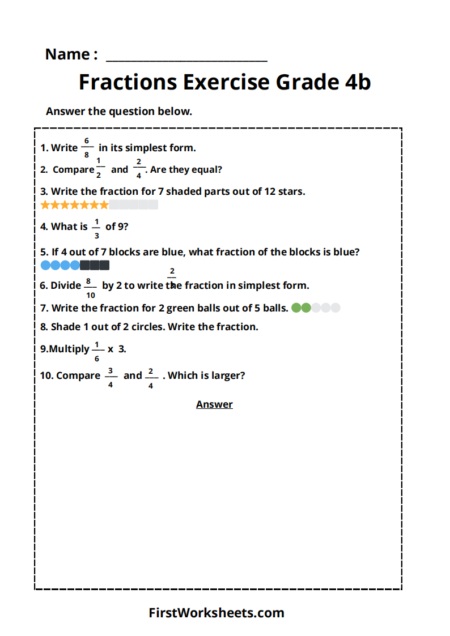This worksheet is designed to introduce and reinforce the concept of fractions visually and interactively. The primary purpose of this worksheet is to help students understand the relationship between parts and wholes, and how to represent these relationships using fractions.
Key Features and Purpose:
- Visual Representation: The worksheet uses shapes, such as squares, triangles, circles, and hearts, to visually represent fractions. This helps learners connect the abstract concept of fractions with concrete examples.
- Shading Activities: The worksheet asks students to shade specific portions of shapes, allowing them to engage with the concept of fractions physically. This hands-on activity reinforces understanding.
- Fraction Identification: Students are asked to identify fractions represented by shaded areas. This encourages them to analyze visual representations and connect them to numerical fractions.
- Fraction Writing: The worksheet prompts students to write fractions based on visual representations and descriptions. This helps them practice expressing parts of a whole using fractional notation.
- Vocabulary Development: The worksheet uses terms like “shaded parts,” “out of,” and “fraction” repeatedly, helping students develop the vocabulary associated with fractions.
- Basic Fraction Concepts: The worksheet focuses on basic fraction concepts, such as representing fractions with numerators and denominators, understanding the meaning of simple fractions (like 1/2, 1/4, 3/8), and recognizing equivalent fractions.
- Gradual Progression: The questions on the worksheet seem to progress in difficulty, starting with simple fractions and moving toward slightly more complex ones. This helps students build their understanding step-by-step.
This worksheet serves as a valuable tool for introducing the concept of fractions to students in a visual, interactive, and engaging way. By combining visual representations, hands-on activities, and practice with fraction notation, the worksheet helps learners develop a solid foundation in understanding fractions.

Answer Key






